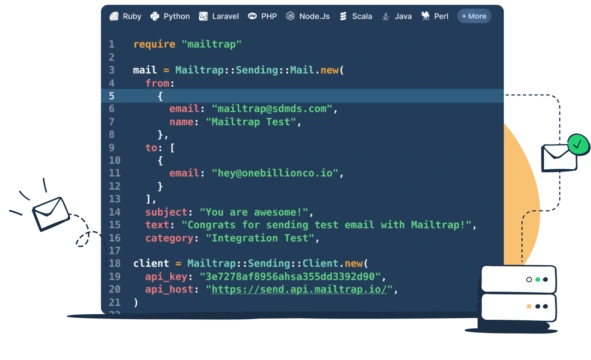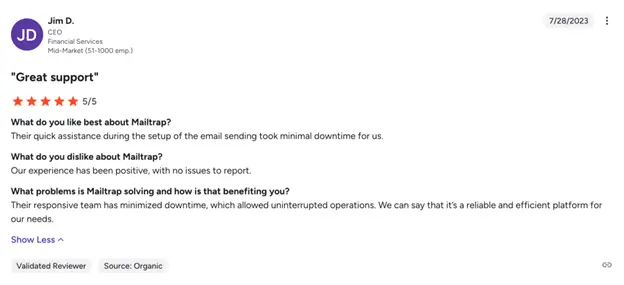Email deliverability remains a critical challenge for businesses. Password reset emails fail to arrive, order confirmations disappear into spam folders, and support tickets pile up with “I never got the email” complaints.
Mailtrap addresses this issue with a focus on high deliverability rates and in-depth analytics. Since 2017, the platform has specialized in ensuring emails reach recipients’ inboxes with detailed performance tracking.
However, with an abundance of email delivery platforms out there in 2025, the question is, is it the right solution for your business?
In this Mailtrap review, we take a closer look at its key features, pricing, pros and cons, and user reviews. This way, you’ll have a better idea of whether it’s the right fit.
What is Mailtrap, and Who is It For?
Mailtrap is a high-deliverability email platform for developer and product teams looking to send marketing, mass, and transactional emails at scale with industry-best analytics. The platform provides helicopter view dashboards and drill-down reports with which you can keep an eye on the performance of your campaigns from various angles.
The service caters to businesses ranging from teams getting their first campaigns off the ground to enterprise teams managing millions of monthly emails. High deliverability rates are included by design across all pricing plans, including the free one.
Mailtrap Key Features
If it hasn’t become obvious yet, Mailtrap’s selling point is high email deliverability. The platform backs this up with several powerful features.
Deliverability features
To achieve high deliverability rates, Mailtrap combines its cloud-based infrastructure with dedicated IP addresses, email warm-up, throttling, and other advanced features.
Additionally, Mailtrap offers separate sending streams to optimize deliverability. You can send transactional and bulk emails at the same time without noticing any hiccups in the performance of your emails.
Email API/SMTP
Mailtrap’s Email API/SMTP service can be quickly integrated with your application/project via 25+ pre-made snippets for major programming languages and frameworks. The platform also supports and maintains official libraries for Node.js, PHP, Ruby, Python, Elixir, and Java.
To get started, you can use the comprehensive documentation, which covers everything from the basic setup to advanced configuration. There are also a plethora of helpful videos and knowledge base articles to help you along every step of your sending journey.

In-Depth Analytics
Once you start sending emails with Mailtrap, you can track their performance via helicopter view dashboards and drill-down reports. Some of the metrics you can track include opens, clicks, bounces, and spam complaints. And, depending on your plan, you can see email logs for up to 30 days.

Email marketing suite
For marketers, Mailtrap provides a campaign builder, a contact management dashboard where you can also segment your recipients, some personalization features, and a few extras.
Of course, there’s a visual email builder with drag-and-drop functionality and AI-powered features for generating subject lines, headlines, and images.

Email templates
And if you’re not feeling creative, you can use email templates, which you can customize without any previous design expertise.
If you have a team of developers at hand, they can use Mailtrap’s HTML editor to create email templates from scratch, host them on the platform, and send them off when they’re ready. The templates use the Handlebars engine, which can be handy for automation.

Customer Support
As of writing this article, you can reach Mailtrap’s customer support via tickets and live chat. Additionally, support availability varies by plan tier:
- Free and Basic plans: Email support during business days
- Business and Enterprise plans: 24/7 customer support, deliverability expert consultation, and migration assistance
It’s also important to note that all support interactions are handled by human representatives rather than automated systems.
Mailtrap Pricing Plans
If you count the free tier, Mailtrap offers four different pricing plans. The higher the plan is, the more advanced features you get. You can also use a slider to determine the number of emails you want to send each month.
Most importantly, high deliverability rates and customer support come with each plan.
| Plan | Monthly Cost | Email Limit | Contacts | Key Features |
| Free | $0 | Up to 3,500 emails | Up to 100 contacts | SMTP relay, email API, drag-and-drop editor, webhooks |
| Basic | From $15 | 10,000+ emails | Up to 50,000 contacts | Email logs (5 days), body retention, click-rate tracking, HTTPS link branding |
| Business | From $85 | 100,000+ emails | Up to 750,000 contacts | Email logs (15 days), dedicated IP, auto warm-up |
| Enterprise | From $750 | 1,500,000 emails | Up to 5,000,000 contacts | All above features + priority support and 30 days email log retention |
Note that the prices and features were relevant at the time of writing but could be subject to change in the future. Additionally, they are month-to-month rates, and Mailtrap offers a discount on an annual subscription.
Pros and Cons
| Pros | Cons |
| High deliverability rates with separate sending streams | Limited native integrations requiring third-party tools |
| In-depth analytics and performance tracking | Automation builder is currently in beta with restricted functionality |
| GDPR compliance, ISO 27001 certification (SOC 2 on the way) | Email log retention periods vary by plan |
| Developer-friendly documentation and setup process | No dedicated IP or SSO on the free plan |
| Generous free plan (3,500 emails/month) | Free plan restricted to single user access |
| Human customer support across all pricing plans | Customer support isn’t available via phone |
What People Say About Mailtrap
Mailtrap receives a lot of love on major review platforms, such as G2 (4.8) or Capterra (4.8).
User feedback frequently highlights setup speed, deliverability improvements after platform migration, and quality of technical documentation. Customer support receives positive reviews for knowledgeable responses and email infrastructure expertise.
For example, here’s what a FinTech user has to say about Mailtrap on G2:

Wrapping Up: Should You Choose Mailtrap in 2025?
Mailtrap provides reliable email delivery with comprehensive analytics, making it suitable for developer and product teams that need consistent inbox placement and detailed performance data.
Choose Mailtrap if you:
- Require high deliverability rates
- Need detailed analytics
- Want human support
- Value comprehensive developer documentation
- Need separate streams for different email types
Consider alternatives if you:
- Require advanced marketing automation workflows
- Need extensive native third-party integrations
- Prefer phone over live chat support for critical issues
Lastly, the generous free plan lets you test the platform’s capabilities and deliverability claims before committing to paid tiers, so be sure to check it out.
Frequently Asked Questions
What is Mailtrap used for?
Mailtrap offers two main products: Email Sending for delivering production emails to users with high deliverability, and Email Testing for safely catching and debugging development emails in a sandbox environment.
Is Mailtrap a real SMTP server?
Mailtrap Email Sending provides a real SMTP server to send emails to your customers. Mailtrap Email Testing provides a “fake” SMTP server that captures emails for testing but does not deliver them.
Is Mailtrap free?
Yes, both Email Sending and Email Testing offer a free plan with limited features, which is great for small projects, individual developers, and testing the platform’s capabilities.
How does Mailtrap ensure deliverability?
Mailtrap uses a combination of a robust cloud infrastructure, dedicated IPs, automated IP warm-up, separate streams for transactional and bulk mail, and in-depth analytics to help users maintain a good sender reputation and high inbox placement rates.








